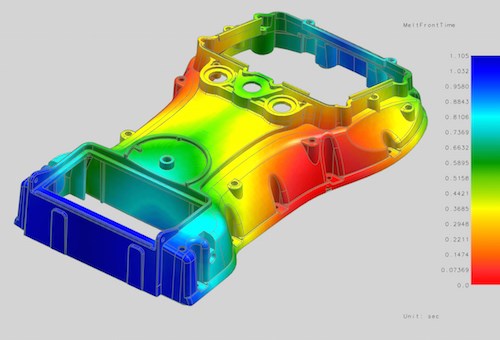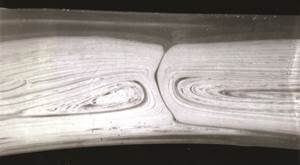The Five “Ms” of Molding—Part II: The Mold
A bad mold can cripple a process; learn what areas should be considered as a tool is evaluated and reviewed.
A bad mold can cripple a process; learn what areas should be considered as a tool is evaluated and reviewed.
Tooling is a key foundation block when developing a work program. A poorly designed or improperly functioning mold can become the root cause for systematic failures. In addition, as continuous improvement projects are outlined, the mold should be reviewed for potential improvements through modification. The next section outlines major areas that should be considered as the tool is evaluated and reviewed:
Design: The very first step of successful molding is how well the mold has been designed to fit a particular application. Molds that do not perform well because of poor processing capabilities, frequent breakage or fluctuating molding conditions are crippling to a company’s productivity and efficiencies. Molding simulation software is a great tool for mold development. The ability to analyze mold temperature, pressure fluctuation and how the flowfront will likely perform greatly improves the designer’s ability to make adjustments to the tooling to counteract potential molding problems before they happen.
Qualification-Tooling: There are many different aspects to mold qualification. The primary goal of qualifying a mold is to develop tooling that consistently produces quality parts at an optimal cycle time. Here is a list of some of the primary areas that are important to mold qualification.
Balancing the runner system: The need to verify that the cavitation is balanced is paramount to a molder’s ability to control his process. Part weights should be consistent and equal. Parts that weigh more or less than the mean should be adjusted by making changes to the gates. Sprue, runners and gates should allow for adequate filling based on material properties.
Mold Temperature: The ability to heat or cool the mold consistently is a vital part of building a consistent process. The mold faces should be checked in multiple areas to verify that temperatures are equal and consistent. Hot or cold spots can cause major inconsistencies. Adding or removing circuits might be needed to accomplish this. In addition, the mold circuitry should be clearly marked to prevent irregular set ups and assure turbulent flow and consistent direction. It is important to measure mold temperature variability in a running state to assure that mold temperature is consistent and not affecting process via hot or cold spots in the mold during molding.
Venting: Verify that the mold has adequate venting to meet the needs of the molding application.
Validation-Process: Process validation assures that once a process has been developed, the set-up of that process will be repeatable and consistent. Here is a list of some of the primary process controls that should be reviewed to assure that an established process is true and dependable:
Melt Temperature: Melt temperature should be verified to be within the recommended temperature window supplied within MSDS data by the material manufacturer.
Barrel Temperature: While the process is in a running state, compare actual temperatures to set points. Conditions that allow heats to ride above what the set points dictate create inconsistency in the process.
Velocity vs. Fill time: Injection speed should allow room for adjustment as determined by the fill time of a process. If increasing velocity set points does not decrease the fill time, injection speed is maxed out and the potential for process variance increases.
Cushion: Cushion should remain consistent to assure that the process is stable.
Peak Pressure: Pressure at cut-off should be verified as consistent, and must not be pressure limited by the maximum pressure limit setting. The pressure limit set point should generally be about 200 PSI higher than the peak pressure achieved.
Mold & Area Set up: There are a variety of situations where slight or even major set up variations can affect the ability to repeat a process. Here is a list of factors to consider when developing your mold set up plan:
Water: It is important to repeat your water set up consistently. Once process has been established, clearly identify supply and return lines to prevent circulation from changing one set to the next. Identify hoses using color and mark circuits
Hot Runner: Whenever possible, use the same hot runner box every time you run a mold.
Clamp Force: Record and verify that tonnage used stays consistent. Variability in tonnage setpoints can lead to poor venting or flash.
Next week, part 3 of the Five M’s of Molding: Material.
Garrett MacKenzie is the owner and editor of www.plastic411.com. Mackenzie started in plastics at the age of 19 as an operator, eventually moving up through the ranks to engineering and management over a 29-year timeframe. He currently works as a plastic injection consultant in engineering and training capacities. He can be contacted at garrett.mackenzie@mail.com.
(Image courtesy Moldex 3D)

Related Content
What to Do About Weak Weld Lines
Weld or knit lines are perhaps the most common and difficult injection molding defect to eliminate.
Read MoreHow to Get Rid of Bubbles in Injection Molding
First find out if they are the result of trapped gas or a vacuum void. Then follow these steps to get rid of them.
Read MoreHow to Select the Right Tool Steel for Mold Cavities
With cavity steel or alloy selection there are many variables that can dictate the best option.
Read MoreRead Next
Processor Turns to AI to Help Keep Machines Humming
At captive processor McConkey, a new generation of artificial intelligence models, highlighted by ChatGPT, is helping it wade through the shortage of skilled labor and keep its production lines churning out good parts.
Read MoreAdvanced Recycling: Beyond Pyrolysis
Consumer-product brand owners increasingly see advanced chemical recycling as a necessary complement to mechanical recycling if they are to meet ambitious goals for a circular economy in the next decade. Dozens of technology providers are developing new technologies to overcome the limitations of existing pyrolysis methods and to commercialize various alternative approaches to chemical recycling of plastics.
Read MoreWhy (and What) You Need to Dry
Other than polyolefins, almost every other polymer exhibits some level of polarity and therefore can absorb a certain amount of moisture from the atmosphere. Here’s a look at some of these materials, and what needs to be done to dry them.
Read More

















.png;maxWidth=300;quality=90)








